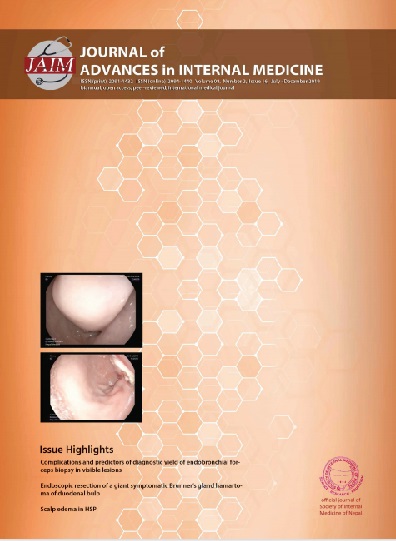Socio-demographic and Clinical Characteristics of Patients with Ulcerative Colitis at a Tertiary Care Centre in Nepal
DOI:
https://doi.org/10.3126/jaim.v8i2.28003Keywords:
Clinical characteristics, Demographics, Inflammatory bowel disease, Ulcerative ColitisAbstract
Introduction: The prevalence of ulcerative colitis (UC) has gradually increased in Asia over the last few decades. However, there is a paucity of data regarding UC in Nepal. This study analyzed the socio-demographic and clinical characteristics of patients hospitalized with UC.
Methods: This is a hospital based, cross-sectional study. Data was collected among 100 individuals admitted to the hospital with UC from June 2016 to May 2018. A descriptive analysis of the demographic and clinical characteristics was done.
Results: Of the 100 patients 51 were male (M:F ratio 1.04:1). Average age at diagnosis was 38}12.53 years. 55% of the patients were Brahmins, 16% Kshetris, 8% Newars, 1% Muslim while the remaining 20% belonged to other indigenous ethnic groups. 79% of the patients were newly diagnosed cases while remaining 21% were admitted for acute flares of the disease. Rectal bleeding (85%) was the most common symptom followed by diarrhea (70%), tenesmus (63%), urgency (61%), pain abdomen (44%), weight loss (14%), fever (7%) and constipation (4%). Clinically, 41% had mild, 46% had moderate and 12% had severe disease activity. Extra intestinal manifestations were seen only in 12% of the patients. On colonoscopic examination, 41% had proctitis, 46% had left sided colitis and 13% had extensive colitis.
Conclusion: Our study showed some differences in the demographic variables as well as clinical manifestations in the patients when compared to data from the west and even other Asian countries like India and China. Larger population-based studies are needed to better understand the epidemiology and characteristics of the disease in Nepal.
Downloads
Downloads
Published
How to Cite
Issue
Section
License
This license enables reusers to distribute, remix, adapt, and build upon the material in any medium or format, so long as attribution is given to the creator.




